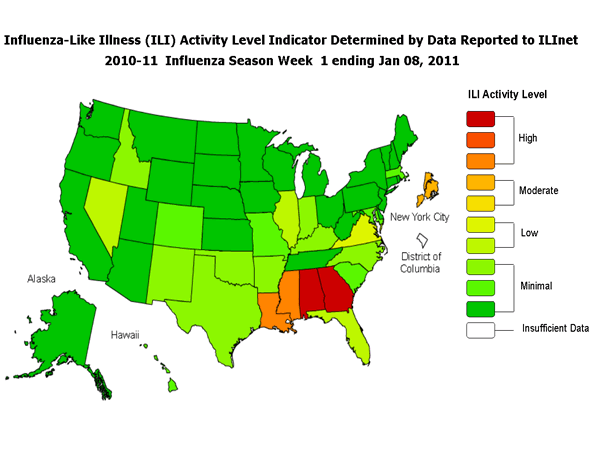Error processing SSI file

2010-2011 Influenza Season Week 01 ending January 8, 2011
All data are preliminary and may change as more reports are received.
Synopsis:
During week 1 (January 2-8, 2011), influenza activity in the United States decreased in several indicators, but it is unlikely that influenza activity for this season has peaked.
- Of the 4,331 specimens tested by U.S. World Health Organization (WHO) and National Respiratory and Enteric Virus Surveillance System (NREVSS) collaborating laboratories and reported to CDC/Influenza Division, 706 (16.3%) were positive for influenza.
- The proportion of deaths attributed to pneumonia and influenza (P&I) was at the epidemic threshold.
- Four influenza-associated pediatric deaths were reported. Two of these deaths were associated with influenza A (H3) viruses and two were associated with influenza B virus infection.
- The proportion of outpatient visits for influenza-like illness (ILI) was 2.2%, which is below the national baseline of 2.5%. One of the 10 regions (Region 4) reported ILI above region-specific baseline levels. Four states experienced high ILI activity, New York City experienced moderate ILI activity, four states experienced low ILI activity, 42 states experienced minimal ILI activity, and data were insufficient from the District of Columbia.
- The geographic spread of influenza in 11 states was reported as widespread; 17 states reported regional influenza activity; the District of Columbia and 16 states reported local influenza activity; the U.S. Virgin Islands, and six states reported sporadic influenza activity, and Guam reported no influenza activity.
| HHS Surveillance Regions* | Data for current week | Data cumulative since October 3, 2010 (Week 40) | ||||||||
|---|---|---|---|---|---|---|---|---|---|---|
| Out-patient ILI† | % positive for flu‡ | Number of jurisdictions reporting regional or widespread activity§ | A (H3) | 2009 A (H1N1) | A(Subtyping not performed) | B | Pediatric Deaths | |||
| Nation | Normal | 16.3% | 29 of 54 | 2,850 | 467 | 2,258 | 3,189 | 8 | ||
| Region 1 | Normal | 31.3% | 4 of 6 | 238 | 22 | 0 | 12 | 0 | ||
| Region 2 | Normal | 17.9% | 3 of 4 | 150 | 11 | 207 | 20 | 3 | ||
| Region 3 | Normal | 16.1% | 3 of 6 | 222 | 61 | 56 | 41 | 1 | ||
| Region 4 | Elevated | 24.2% | 8 of 8 | 418 | 142 | 1,047 | 2,235 | 2 | ||
| Region 5 | Normal | 38.0% | 3 of 6 | 314 | 79 | 20 | 86 | 0 | ||
| Region 6 | Normal | 25.6% | 3 of 5 | 245 | 9 | 368 | 391 | 1 | ||
| Region 7 | Normal | 14.1% | 2 of 4 | 68 | 14 | 105 | 29 | 0 | ||
| Region 8 | Normal | 28.2% | 1 of 6 | 748 | 67 | 376 | 48 | 0 | ||
| Region 9 | Normal | 19.4% | 2 of 5 | 385 | 56 | 68 | 311 | 1 | ||
| Region 10 | Normal | 7.9% | 0 of 4 | 62 | 6 | 11 | 16 | 0 | ||
*HHS regions (Region 1 CT, ME, MA, NH, RI, VT; Region 2: NJ, NY, Puerto Rico, US Virgin Islands; Region 3: DE, DC, MD, PA, VA, WV; Region 4: AL, FL, GA, KY, MS, NC, SC, TN; Region 5: IL, IN, MI, MN, OH, WI; Region 6: AR, LA, NM, OK, TX; Region 7: IA, KS, MO, NE; Region 8: CO, MT, ND, SD, UT, WY; Region 9: AZ, CA, Guam, HI, NV; and Region 10: AK, ID, OR, WA).
† Elevated means the % of visits for ILI is at or above the national or region-specific baseline
‡ National data are for current week; regional data are for the most recent three weeks
§ Includes all 50 states, the District of Columbia, Guam, Puerto Rico, and U.S. Virgin Islands
U.S. Virologic Surveillance:
WHO and NREVSS collaborating laboratories located in all 50 states and Washington D.C. report to CDC the number of respiratory specimens tested for influenza and the number positive by influenza type and subtype. The results of tests performed during the current week are summarized in the table below.
| Week 1 | |
|---|---|
| No. of specimens tested | 4,331 |
| No. of positive specimens (%) | 706 (16.3%) |
| Positive specimens by type/subtype | |
| Influenza A | 521 (73.8%) |
| A (2009 H1N1) | 40 (7.7%) |
| A (subtyping not performed) | 317 (60.8%) |
| A (H3) | 164 (31.5%) |
| Influenza B | 185 (26.2%) |
All 50 states and the District of Columbia have reported laboratory-confirmed influenza this season.

View WHO-NREVSS Regional Bar Charts | View Chart Data | View Full Screen | View PowerPoint Presentation
Aggregate Hospitalization and Death Reporting Activity (AHDRA):
This system tracks weekly counts of laboratory-confirmed influenza-associated hospitalizations and deaths and was implemented on August 30, 2009, during the 2009 pandemic, and ended on April 4, 2010. AHDRA surveillance during the 2010-11 season is being continued on a voluntary basis and 13 jurisdictions reported during week 1. From October 3, 2010-January 8, 2011, 1,827 laboratory-confirmed influenza associated hospitalizations and 28 laboratory-confirmed influenza associated deaths were reported to CDC.

View Full Screen | View Chart Data | View PowerPoint Presentation
Antigenic Characterization:
CDC has antigenically characterized 257 influenza viruses [29 2009 influenza A (H1N1) viruses, 137 influenza A (H3N2) viruses, and 91 influenza B viruses] collected by U.S. laboratories since October 1, 2010.
- All 29 were characterized as A/California/7/2009-like, the influenza A (H1N1) component of the 2010-11 influenza vaccine for the Northern Hemisphere.
2009 Influenza A (H1N1) [29]
- All 137 were characterized as A/Perth/16/2009-like, the influenza A (H3N2) component of the 2010-11 influenza vaccine for the Northern Hemisphere.
Influenza A (H3N2) [137]
- Eight-three (91%) of the 91 influenza B viruses tested belong to the B/Victoria lineage of viruses and were characterized as B/Brisbane/60/2008-like, the recommended influenza B component for the 2010-11 Northern Hemisphere influenza vaccine.
Influenza B (B/Victoria/02/87 and B/Yamagata/16/88 lineages) [91]
Victoria Lineage [83]
- Eight (9%) of the 91 viruses were identified as belonging to the B/Yamagata lineage of viruses.
Yamagata Lineage [8]
Antiviral Resistance:
Testing of 2009 influenza A (H1N1), influenza A (H3N2), and influenza B virus isolates for resistance to neuraminidase inhibitors (oseltamivir and zanamivir) is performed at CDC using a functional assay. Additional 2009 influenza A (H1N1) clinical samples are tested for a single known mutation in the neuraminidase protein of the virus that confers oseltamivir resistance (H275Y). The data summarized below combine the results of both test methods and includes samples that were tested as part of routine surveillance purposes; it does not include diagnostic testing specifically done because of clinical suspicion of antiviral resistance.
High levels of resistance to the adamantanes (amantadine and rimantadine) persist among 2009 influenza A (H1N1) and A (H3N2) viruses (the adamantanes are not effective against influenza B viruses) circulating globally. As a result of the sustained high levels of resistance, data from adamantane resistance testing are not presented weekly in the table below.
| Samples tested (n) | Resistant Viruses, Number (%) | Samples tested (n) | Resistant Viruses, Number (%) | |
|---|---|---|---|---|
| Oseltamivir | Zanamivir | |||
| Seasonal Influenza A (H1N1) | 0 | 0 (0.0) | 0 | 0 (0.0) |
| Influenza A (H3N2) | 109 | 0 (0.0) | 109 | 0 (0.0) |
| Influenza B | 91 | 0 (0.0) | 91 | 0 (0.0) |
| 2009 Influenza A (H1N1) | 31 | 0 (0.0) | 21 | 0 (0.0) |
To prevent the spread of antiviral resistant virus strains, CDC reminds clinicians and the public of the need to continue hand and cough hygiene measures for the duration of any symptoms of influenza, even while taking antiviral medications. Additional information on antiviral recommendations for treatment and chemoprophylaxis of influenza virus infection is available at http://www.cy118119.com/flu/antivirals/index.htm.
Pneumonia and Influenza (P&I) Mortality Surveillance
During week 1, 7.7% of all deaths reported through the 122-Cities Mortality Reporting System were due to P&I. This percentage was at the epidemic threshold of 7.7% for week 1.
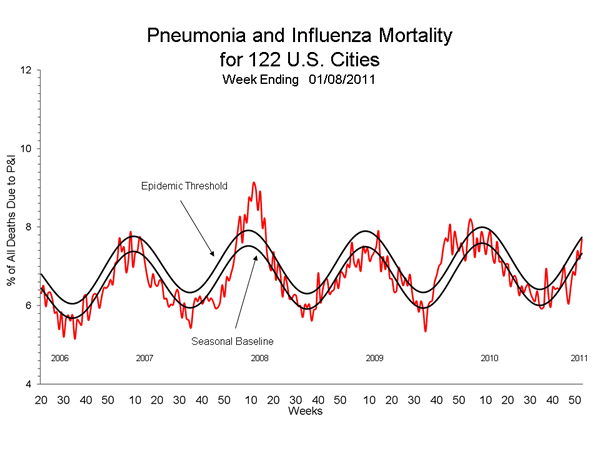
View Full Screen | View PowerPoint Presentation
Influenza-Associated Pediatric Mortality
Four influenza-associated pediatric deaths were reported to CDC during week 1 (Florida, New York, North Carolina, and Pennsylvania). Two of these deaths were associated with nfluenza A (H3) viruses and two were associated with influenza B virus infection. The deaths reported this week occurred between December 19, 2010 and January 8, 2011.
Eight influenza-associated pediatric deaths occurring during the 2010-2011 season have been reported; four deaths were associated with influenza A (H3) virus infection, three deaths were associated with influenza B virus infection, and one was associated with an influenza A virus for which the subtype was not determined.
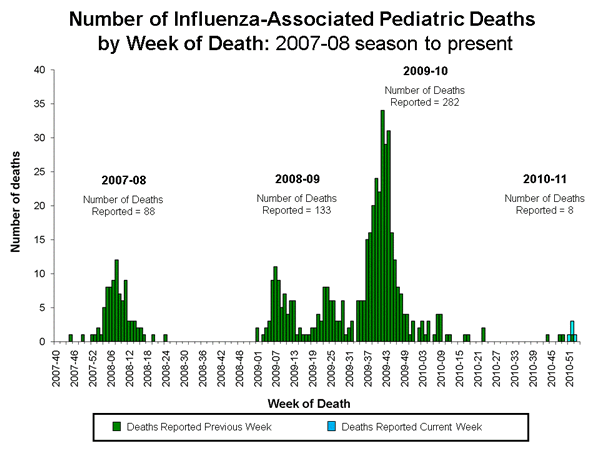
View Full Screen | View PowerPoint Presentation
Influenza-Associated Hospitalizations
FluSurv-NET conducts population-based surveillance for laboratory-confirmed influenza-associated hospitalizations in children (persons younger than 18 years) and adults. The current network covers over 80 counties in the 10 Emerging Infections Program (EIP) states (CA, CO, CT, GA, MD, MN, NM, NY, OR, and TN) and six additional states (ID, MI, OH, OK, RI, and UT).
The current season’s rates include cases from October 1, 2010 to January 11, 2011.
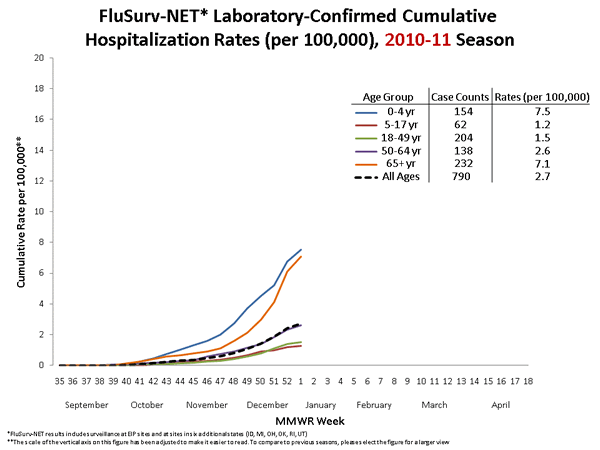
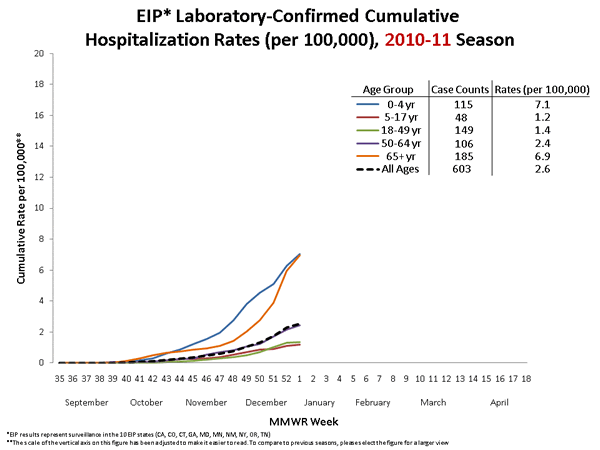
Click here to view rates for 2010-2011 season | View PowerPoint Presentation
Click here to view rates for 2008-2009 season
Click here to view rates for 2007-2008 season
Please note the following: (i) The scale of the vertical axis on the Cumulative Hospitalization Rate figures for the current season has been adjusted on FluView to make it easier to read. (ii) FluSurv-NET was created during the 2009-2010 season when surveillance in six states was added to ongoing surveillance for influenza-associated hospitalizations in10 EIP states. During the 2009-2010 season, FluSurv-NET included sites in the 10 EIP sites and sites in IA, ID, MI, ND, OK, and SD; (iii) the 2008-2009 EIP season ended April 14, 2009, due to the onset of the 2009 H1N1 pandemic
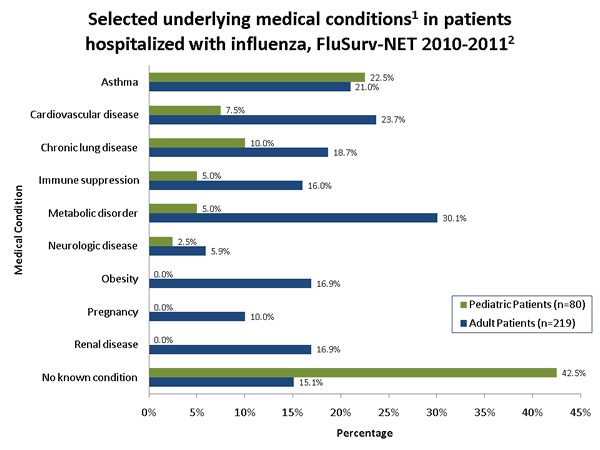
View Full Screen
1Asthma may include a diagnosis of asthma and reactive airway disease; Cardiovascular diseases may include conditions such as coronary heart disease, cardiac valve disorders, congestive heart failure, pulmonary hypertension, and aortic stenosis; Chronic lung diseases may include conditions such as bronchiolitis obliterans, chronic aspiration pneumonia, and interstitial lung disease; Immune suppression may include conditions such as immunoglobulin deficiency, leukemia, lymphoma, HIV/AIDS, and individuals taking immunosuppressive medications; Metabolic disorders may include conditions such as diabetes mellitus, thyroid dysfunction, adrenal insufficiency, and liver disease; Neurologic diseases may include conditions such as seizure disorders, neuromuscular disorders, and cognitive dysfunction; Obesity was defined as a body mass index (BMI) greater than 30 kg/m2 in patients 20 years of age or older, or equal to or greater than the 95th percentile of a patient’s age and sex category in patients under 20 years of age; Renal diseases may include conditions such as acute or chronic renal failure, nephrotic syndrome, glomerulonephritis, and impaired creatinine clearance.
2Data as of January 11, 2011. Includes 299 (of a total 817 reported) cases for which data collection has been completed through the medical chart review stage.
|
2010-2011 FluSurv-NET3 N (%) |
2009-2010 FluSurv-NET3 N (%) |
2008-2009 EIP N (%) |
2007-2008 EIP N (%) |
2006-2007 EIP N (%) |
|---|---|---|---|---|---|
| Total Cases | 817 | 7,518 | 1,698 | 3,930 | 1,279 |
| Age in Years 0-4 5-17 18-49 50-64 65+ |
157 (19.2) 65 (8.0) 208 (25.5) 140 (17.1) 246 (30.1) |
1,326 (17.6) 1,204 (16.0) 2,780 (37.0) 1,458 (19.4) 750 (10.0) |
549 (32.3) 244 (14.4) 374 (22.0) 201 (11.8) 330 (19.4) |
637 (16.2) 221 (5.6) 735 (18.7) 585 (14.9) 1,749 (44.5) |
393 (30.7) 130 (10.2) 246 (19.2) 155 (12.1) 355 (27.8) |
| Sex Male Female |
384 (47.0) 431 (52.8) |
3,517 (46.8) 4,001 (53.2) |
832 (49.0) 866 (51.0) |
1,825 (46.4) 2,104 (53.5) |
631 (49.3) 648 (50.7) |
| Flu Type and Subtype Influenza A Specimens subtyped4 A (H1) A (H3) A (2009 H1N1) Influenza B |
550 (67.3) 107 0 (0.0) 96 (89.7) 11 (10.3) 204 (25.0) |
7,356 (97.9) 5,280 0 ( 0.0) 3 (< 0.1) 5,277 (99.9) 52 (0.7) |
1,236 (72.8) -- -- -- -- 382 (22.5) |
2,558 (65.1) -- -- -- -- 1,199 (30.5) |
1,082 (84.6) -- -- -- -- 149 (11.7) |
| Intensive Care Unit | 40 (13.1) | 1,547 (20.8) | 298 (17.6) | 495 (12.6) | 198 (15.5) |
| Mechanical Ventilation | 10 (3.3) | 751 (10.1) | 157 (9.3) | 252 (6.4) | 111 (8.7) |
| Diagnosis of Pneumonia | 66 (21.6) | 2,784 (37.4) | 407 (24.0) | 1,220 (31.0) | 404 (31.6) |
| Died | 5 (1.6) | 220 (3.0) | 49 (2.9) | 104 (2.7) | 24 (1.9) |
Columns may not sum to 100% due to missing or unknown values.
1Surveillance in EIP states (CA, CO, CT, GA, MD, MN, NM, NY, OR, TN) was conducted from 2006-2011.
2FluSurv-Net includes surveillance at EIP sites and at sites in additional states (IA, ID, MI, ND, OK, SD in 2009-2010; ID, MI, OH, OK, RI, UT in 2010-2011).
3Data as of January 11, 2011. Results describing influenza A subtype, intensive care unit admission, mechanical ventilation, diagnosis of pneumonia, and death are from 7,441 (of a total 7,518 reported) and 305 (of a total 817 reported) cases for which data collection has been completed through the medical chart review stage for the 2009-2010 and 2010-2011 seasons, respectively.
4Influenza A subtype results are available beginning with the 2007-2008 season. Percentages for influenza A subtypes are calculated using the number of influenza A specimens that were subtyped as a denominator.
Outpatient Illness Surveillance:
Nationwide during week 1, 2.2% of patient visits reported through the U.S. Outpatient Influenza-like Illness Surveillance Network (ILINet) were due to influenza-like illness (ILI). This percentage is below the national baseline of 2.5%.

View ILINet Regional Charts | View Chart Data | View Full Screen | View PowerPoint Presentation
On a regional level, the percentage of outpatient visits for ILI ranged from 0.4% to 3.4% during week 1. One of the 10 regions (Region 4) reported a proportion of outpatient visits for ILI above region-specific baseline levels.
ILINet State Activity Indicator Map:
Data collected in ILINet are used to produce a measure of ILI activity* by state. Activity levels are based on the percent of outpatient visits in a state due to ILI and are compared to the average percent of ILI visits that occur during spring and fall weeks with little or no influenza virus circulation. Activity levels range from minimal, which would correspond to ILI activity from outpatient clinics being below the average, to high, which would correspond to ILI activity from outpatient clinics being much higher than the average. Because the clinical definition of ILI is very general, not all ILI is caused by influenza; however, when combined with laboratory data, the information on ILI activity provides a clear picture of influenza activity in the United States.
During week 01, the following ILI activity levels were experienced:
- Four states (Alabama, Georgia, Louisiana, and Mississippi) experienced high ILI activity.
- New York City experienced moderate ILI activity.
- Four states (Florida, Illinois, Nevada, and Virginia) experienced low ILI activity.
- Minimal ILI activity was experienced by 42 states (Alaska, Arizona, Arkansas, California, Colorado, Connecticut, Delaware, Hawaii, Idaho, Indiana, Iowa, Kansas, Kentucky, Maine, Maryland, Massachusetts, Michigan, Minnesota, Missouri, Montana, Nebraska, New Hampshire, New Jersey, New Mexico, New York, North Carolina, North Dakota, Ohio, Oklahoma, Oregon, Pennsylvania, Rhode Island, South Carolina, South Dakota, Tennessee, Texas, Utah, Vermont, Washington, West Virginia, Wisconsin, and Wyoming).
- Data were insufficient to calculate an ILI activity level from the District of Columbia.
*This map uses the proportion of outpatient visits to health care providers for influenza-like illness to measure the ILI activity level within a state. It does not, however, measure the extent of geographic spread of flu within a state. Therefore, outbreaks occurring in a single city could cause the state to display high activity levels.
Data collected in ILINet may disproportionately represent certain populations within a state, and therefore, may not accurately depict the full picture of influenza activity for the whole state.
Data displayed in this map are based on data collected in ILINet, whereas the State and Territorial flu activity map are based on reports from state and territorial epidemiologists. The data presented in this map is preliminary and may change as more data is received.
Differences in the data presented by CDC and state health departments likely represent differing levels of data completeness with data presented by the state likely being the more complete.
Geographic Spread of Influenza as Assessed by State and Territorial Epidemiologists:
The influenza activity reported by state and territorial epidemiologists indicates geographic spread of influenza viruses, but does not measure the severity of influenza activity.
During week 01, the following influenza activity was reported:
- Widespread influenza activity was reported by 11 states (Alabama, Arizona, Connecticut, Kentucky, Louisiana, Maryland, Nevada, New York, North Carolina, Tennessee, and Virginia).
- Regional influenza activity was reported by 17 states (Colorado, Florida, Georgia, Illinois, Indiana, Kansas, Maine, Massachusetts, Mississippi, Missouri, New Hampshire, New Jersey, Ohio, Oklahoma, Pennsylvania, South Carolina, and Texas).
- Local influenza activity was reported by the District of Columbia and 16 states (Alaska, Arkansas, California, Idaho, Iowa, Michigan, Minnesota, Montana, Nebraska, New Mexico, North Dakota, Rhode Island, South Dakota, Washington, West Virginia, and Wyoming).
- Sporadic influenza activity was reported by the U.S. Virgin Islands and six states (Delaware, Hawaii, Oregon, Utah, Vermont, and Wisconsin).
- Guam reported no influenza activity.
- Puerto Rico did not report.
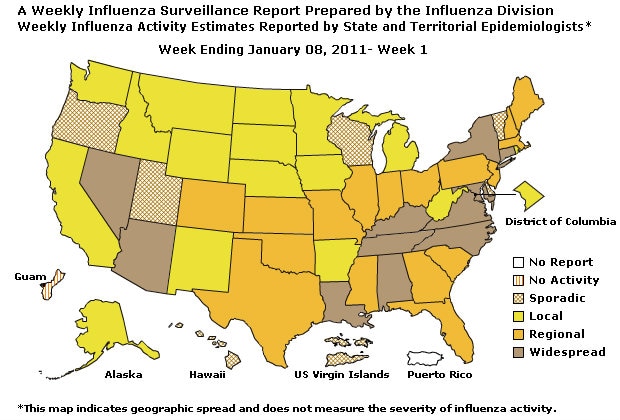
Additional National and International Influenza Surveillance Information
U.S. State and local influenza surveillance: Click on a jurisdiction below to access the latest local influenza information.
Distribute Project: Additional information on the Distribute syndromic surveillance project, developed and piloted by the International Society for Disease Surveillance (ISDS) now working in collaboration with CDC, to enhance and support Emergency Department (ED) surveillance, is available at http://isdsdistribute.org/
Google Flu Trends: Google Flu Trends uses aggregated Google search data in a model created in collaboration with CDC to estimate influenza activity in the U.S. For more information and activity estimates from the U.S. and worldwide, see http://www.google.org/flutrends/
Europe: for the most recent influenza surveillance information from Europe, please see WHO/Europe at http://www.euroflu.org/index.php and visit the European Centre for Disease Prevention and Control at http://ecdc.europa.eu/en/Activities/Surveillance/EISN/Pages/home.aspx
Public Health Agency of Canada: The most up to date influenza information from Canada is available at http://www.phac-aspc.gc.ca/fluwatch/
World Health Organization FluNet: Additional influenza surveillance information from participating WHO member nations is available at http://gamapserver.who.int/GlobalAtlas/home.asp
--------------------------------------------------------------------------------
A description of surveillance methods is available at: http://www.cy118119.com/flu/weekly/overview.htm
